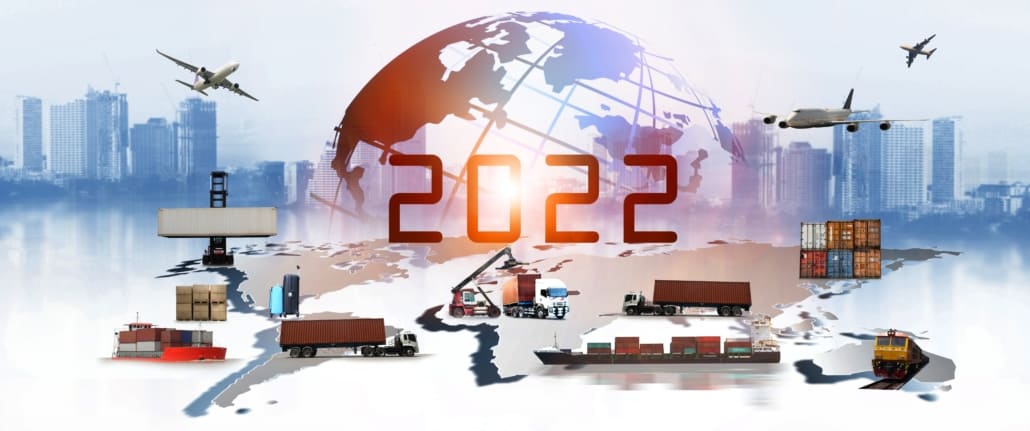Supply Chain Lessons from 2022
How supply chain events between 2020 and 2022 will shape companies’ processes in 2023?
What lessons to learn from 2022? Read Here!
Table of content:
Industries worldwide continue to experience supply chain disruptions. Businesses in various sectors find it challenging to optimize operations, reduce risk, improve dexterity, and determine methods to stay afloat in the market. Overcoming these challenges requires supply chain companies to analyze the complications between 2020 and 2022 and modify their strategies accordingly.
Besides, achieving these goals requires supply chain companies to overcome labor challenges, implement the latest digital tools and software applications, optimize sourcing and inventory management, and focus on client-oriented strategies.

The Covid-19 pandemic increases the duration for imports to reach local companies and warehouses. Because import prices continue to rise, businesses shift product sourcing from foreign countries to closer locations. At the same time, companies diversify their suppliers to ensure efficiency, reliability, and cost-effectiveness.
In addition, storing inventory closer to consumers is trending nowadays. However, this requires businesses to build and foster long-term relationships with local suppliers. So, the lesson learned from 2022 is that companies witness a paradigm shift away from mass manufacturing.
Onshore and nearshore supply chains replace long lead times. Nearshoring and onshoring allow companies to manufacture, distribute, and complete orders on demand without labor shortages, ocean freight problems, and other barriers in the supply chain network.
Another lesson learned from 2022 is securing backup inventory storage methods. It has become one of the most significant priorities for companies worldwide. So, finding storage solutions is essential to handle excess inventory and overcome business challenges.
Today, businesses implement strategies to secure backup inventory storage solutions, including 3PL warehousing, subleasing, and co-warehousing. So, if you want to scale your business operations, focus on optimal inventory control, and have the right products in the correct places. The purpose is to fulfill the order when needed.
Multiple smaller storage facilities in strategic locations will help you achieve your goals. However, you must take additional steps to closely analyze the data and ensure correct stock levels at each distribution site. Likewise, it helps you understand where orders come from and how to streamline the process.

Companies that fail to implement a tailored supply chain management solution or software may experience a wide range of complications. A business looking to fix significant problems in its supply chain must digitalize its management.
It enables you to identify additional weak points in the supply chain and develop strategies to address those problems. Supply chain management software can help you determine risks and proactively mitigate them.
So, digitizing your supply chain will make your operations more agile, giving you adaptability and flexibility to respond to disruptions in real-time. Besides, Software based on artificial intelligence and machine learning algorithms can map and monitor different processes and focus on more added-value work.
Risks in the supply chain emerge from suppliers in the lower tier of the network, leading to significant delays and costing companies a substantial amount of money. So, implementing a tailored supply chain software with essential features can help you uncover risks in real-time and optimize business processes.
Supply chain management software analyzes, anticipates, mitigates, and resolves issues. We recommend choosing a software system with mapping and monitoring capabilities. It monitors suppliers and analyzes millions of sources using artificial intelligence.
At the same time, the software finds, understands, and categorizes the risks affecting your suppliers. Software with predictive analytics can help you report on events that pose problems for your business. Predictive analytics enables companies to act proactively and respond to issues promptly.
Companies looking to streamline their supply chain operations must hire experienced, qualified, and skilled supply management staff. Your decisions can make or break your business in 2023, especially if you don’t have a professional team to manage processes.
When you diversify your suppliers, you must make substantial efforts to grow and foster relationships. Hiring and maintaining a team of professionals can optimize processes, manage relationships, and increase revenues because they collaborate and communicate effectively and ensure everyone is on the same page.
Moreover, creating a solid network between your company and your suppliers requires you to put together a team with experience in supplier sourcing. You can develop sales-like key performance indicators and bring qualified account managers to educate and train the team and help them establish targets and goals.
Although this is a daunting, expensive, and time-consuming approach, this will benefit your company in the long run. More and more companies are taking steps in this direction, so you can’t afford to leave your company behind in the race.
Building external partnerships are critical for your business’s continued success. However, you can’t streamline this process and achieve your goals without establishing sophisticated internal relationships.

Diversifying manufacturing networks is a real game-changer for companies in the supply chain. It helps you achieve supply chain resilience. For instance, finding new suppliers ensures your business continues optimizing critical processes, irrespective of potential supply chain risks.
For example, if one supplier can’t deliver because the circumstances do not allow it to do so, you must have a backup solution to control things. The purpose is to provide the finished products to your clients without delays.
Remember, you must contract with multiple suppliers to achieve this multi-sourcing method. Likewise, you can create partnerships with sole suppliers in various production locations.
In addition, the risk usually lies in the elevated prices because the order qualities are split between suppliers. So, this diminishes the economies of scale effects and increases purchasing costs due to additional supplier assessment and onboarding.
Focusing on nearshoring is another lesson to learn from 2022’s circumstances in the supply chain industry. Nearshoring allows a business to move its projects/operations to a nearby country. Offshoring enables companies to move their projects to countries with cheap labor and resources.
So, the nearshoring practice has become a trendy topic in today’s business world and politically charged trade environment. The reason is that most countries have increased tariffs on other nations, raising the total landed cost. Thus, nearshoring is an excellent solution to overcome these problems. Nearshoring:
Adapting nearshoring requires implementing high-quality technology tools to make communication more effective and reliable. Supply chain companies quickly adopt nearshoring in various industries to meet their client’s demands and needs.
At the same time, it enables businesses to implement and maintain sustainable practices. Manufacturers invest in automation and nearshoring to compete with companies having a solid digital presence and increase profitability.

Automation and advanced analytics continue to accelerate, helping companies reduce supply chain disruptions through digital and agile management. We recommend companies must implement predictive and prescriptive analytics with advanced robotics, machine learning algorithms, big data, and artificial intelligence.
Companies focusing on these cutting-edge solutions can leverage greater visibility, efficiency, and data-driven decision-making. As a result, they can achieve higher predictability, data analysis, streamlined operations, and increased profitability.
Remember, everything in today’s world depends on effective data governance, operations, and security. Supply chain resilience requires data experience, cutting-edge solutions, and solid communication between global networks, allowing companies to prevent complexities and promote interconnectedness. Key strategies to implement are:
Advanced analytics and correct usage of digital tools can help companies develop resilient supply chain designs, allowing them to mitigate adverse events efficiently, reliably, and quickly.
These technologies also equip companies with real-time insights that help them stay competitive, provide optimal customer service, generate value, and improve market share.
Digital supply chains are integral to businesses in various industries, promoting visibility, agility, and resilience. Digitized networks use cutting-edge technologies to augment data collection and workflow.
At the same time, digitizing operations can streamline data infrastructures, enabling companies to achieve real-time data analysis and generate valuable insights to make informed decisions.
A company that makes substantial efforts to digitize supply chains requires robust sensor implementation through shared external and internal interfaces, the internet of things (IoT), and cloud-based networks.
Cybersecurity protects sensitive data and prevents hackers and criminals from accessing or penetrating your company’s systems. Adopting blockchain, machine learning, and artificial intelligence will improve decision-making.
In addition, cybersecurity protocols and methods can also protect supply chain networks from online threats, malware, ransomware, and other cyberattacks. On the other hand, if you fail to implement cybersecurity techniques, these threats will affect your supply chain operations.
Moreover, interconnectedness can cause supply chain partners in the network to expose each other and their client’s data, leading to privacy breaches and identity theft. However, you can reduce these risks by safeguarding networks, people, devices, software, applications, and programs.

Supply chains experienced massive shifts in 2020, 2021, and 2022 because the Covid-19 pandemic negatively impacted businesses worldwide. Although numerous supply chain practices from 2020 and 2021 continued in 2022, companies must learn lessons from the complications they experienced to modify their strategies and optimize their operations.
The pandemic, Russia-Ukraine war, geopolitical events, and other factors may persist in 2023, so supply chain planners must prepare themselves for increased variability, demand, and volatility in supply, production, sales, and operations.
The strategies above can help companies overcome challenges and optimize their business processes to stay afloat, reduce the effects of inflation and recession, and prevent the risk of financial losses. Until Next Time!

 How Do Remote Work and Working from Home Affect Supply Chain?
How Do Remote Work and Working from Home Affect Supply Chain?